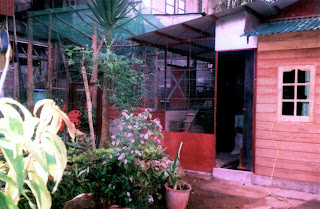Last Tuesday, the 23rd of August, I put in some rice straw that we sourced out from one of our neighbors in the chicken's plastic nest boxes. Earlier in the day, we heard Henrietta the pet hen, making the usual cackling sound as if she is demanding for us to provide her with a nest as she is about ready to lay an egg. As soon as I finished lining up the nest box, I brought it inside the coop and was tying the nest boxes so it would not fall down when all of a sudden, Henrietta flew right in and started scratching in the nest box. It's like she's saying "Hurry up and get out or I will lay an egg on your head!" Well I really got out as fast as I can and left her making her still cackling as if she's letting the whole neighborhood know that she is about ready to lay an egg. The brown chicken from Kapangan who looked ready to lay an egg too was cackling also and she went on the roost and was peeking at Henrietta. She was curious on what the latter was doing or why she is scratching inside the nest. Then the brown hen jumped down and went flying on one of the nest boxes while Henrietta was making a sound as if saying "Don't get near me!". As the brown hen was contemplating on what to do next, Henrietta got out of her nest and was cackling away and by this time, the brown hen went into Henrietta's nest box. By this time, the big rooster joined Henrietta in a cackling singing contest and brown hen chimed in so there was a trio! I really believe that they are trying to tell the young brown hen that the nest is where she could lay her eggs. Since it was about lunchtime, I left the singing choir of chickens doing their concert and went inside the house to fix lunch for my hubby and myself.
As of today, the 28th of August, in spite of the rain that is lambasting our city, the native chickens are laying their eggs, well two of them anyway. Henrietta who claimed the first nest has laid 6 small eggs and the one brown pullet that came from Kapangan also laid her first egg today in the last nest box. I am assuming that they did not use the same nest box together because there is one egg in the last box so I figured that must be from the brown pullet. The brown pullet and the big rooster both came from Kapangan and they are siblings. Since one of Henrietta's chicks turned out to be a roo, so I don't know which of the two roo mated with the brown pullet. I know that Henrietta is always being chased by both rooster including all of the other chickens in the coop. They pick on her all of the time which is why her feathers are all ruffled up. Both roosters likes to jump on her whenever they get a chance. She tries to stay away from all of the other chickens but for some reason, they wouldn't let her eat in peace. Whenever she gets down from the roost or from the nest to eat, the others would chase her away. I guess maybe because she didn't grow up with the rest. I wonder if I should put her in a separate coop of her own. We still have the small coop where we used to house her when she first came to us. Maybe I will do that to keep the peace in the coop. It's just that I am wondering if I should put the big rooster in with her in the separate coop? What do you think?





















